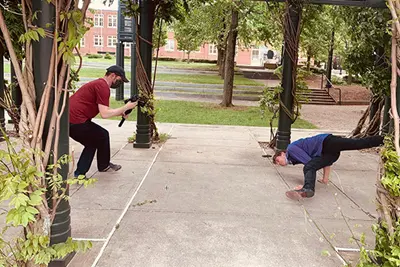Ensemble Class’s “Dark Side of the Moon” Performance Goes Viral

12/10/2020
By David Perry
A video of a music ensemble class’s performance of Pink Floyd’s “Dark Side of the Moon” has gone viral, earning praise from far and wide, logging more than 20,000 views in its first full day on YouTube.
The video vividly captures the culmination of the fall semester’s work by The Pink Floyd Ensemble, a class named for the iconic English band. The class is taught by Music Prof. Alan Williams, who decided the group would learn and perform Floyd’s 1973 masterpiece, which is hailed as an artistic and technical triumph, and has spent more than 950 weeks on the charts, selling more than 45 million copies worldwide.
Williams knew there was no excusing a subpar performance, even during a pandemic that had students performing the song “Breathe” in face masks. “If it was lousy, no one would have heard or seen it,” Williams says with a chuckle.
But comments from across the globe are overwhelmingly positive, even reflective. “You made me cry with your performance, folks,” one viewer wrote after watching the video. Williams says one commenter, who praised the performance, works for Roger Waters, Pink Floyd’s bassist/vocalist and the album’s lyricist.
Much of the praise has gone to the trio of women – Kamryn Richard, Mia Farwell and Kaitlin Whiteman, who turned on a stunning rendition of session singer Clare Torry’s impressionistic vocal on “The Great Gig in the Sky,” a cornerstone of the album.
“I’m shocked by the response,” says Richard, a senior music business major from Townsend, Massachusetts, who was first of the three to vocalize on “Great Gig.” “I thought it would go over well around school. To see it practically blowing up on YouTube and social media feels amazing. It’s so nice to see positive feedback from the people who’ve watched.”
She learned the wordless “Great Gig” section by listening over and over to the original, then learning it section by section.
“We were so inspired by collective music making that everyone not only brought their A game, but also delivered performances they didn't know they had in them,” says Williams.
It is the second year the ensemble class has rendered a rock classic, but last year’s project, King Crimson’s “In The Court of the Crimson King,” was performed live before an audience in Durgin Hall. A spring semester performance of Crimson’s “Red” album was scrapped when the pandemic arrived.
“This semester,” says Williams, “I thought, what album would we be able to do live and with this group of students?”
The video was shot by Williams and Jude Porter, the son of Williams’ bandmate Greg Porter, with ensemble guitar player Leo Folan contributing. The footage was edited by Williams.
During the semester, classes were conducted over Zoom, with painstaking listening and plotting of who would play what. Recording was staggered in slots of six or seven players to adhere to social distancing standards.
“Some students had never met before, and we even tracked a couple of songs before one of the students waved to another to introduce himself,” says Williams.
Only because it is his roommate’s favorite record, “Dark Side of the Moon” was familiar to Connor Capozzi, a fifth-year electrical engineering and sound recording technology (SRT) major from Windham, New Hampshire, who played keyboards and Ableton (a digital audio workstation and instrument) on the session. “I’d have been hard-pressed to name any songs other than ‘Money’” when the semester began, Capozzi says. Now, it’s one of his favorite albums."
He was part of the King Crimson performance a year ago, calling it “an incredible experience.” This year’s performance was different, but also rewarding. “Pulling the whole thing together this time was an interesting process, to say the least,” Capozzi says. “We all needed to have trust in each other to really know our parts. It was an especially weird experience, since many of us had never met before.”
Software called SoundTrap served as “an audio Google Doc where students could hone their parts and add to the mix,” says Williams.
“It took dedication from everyone,” says Capozzi, “and an attention to detail that would impress even the most hardcore fans of the album. I know that I spent hours listening to songs like ‘On The Run,’ noting all the effects so that if someone went looking for their favorite random sound or piece of dialogue, they'd be able to find it.”
Capozzi was the last performer to layer on sections in the studio. “I got to hear all the rough session mixes, and I knew immediately that we had something special,” he says. “I had no idea, however, that the video would reach as far as it already has, and I'm absolutely floored. I'm glad that during such a time of uncertainty, we were able to put together something that is bringing so many people together.”
This recording isn’t UML’s first dance with Pink Floyd’s masterpiece. Two years ago, the man who engineered the album, Alan Parsons, stopped by Durgin Hall to speak to students in the SRT program. And alumnus and Grammy-winning recording engineer Joel Plante ’97 has worked since 1998 at James Guthrie’s das boot recording, the studio where his remastering projects have included “Dark Side of the Moon” and several other Pink Floyd albums.
This time around, the restrictions tied to the coronavirus pandemic may have made the students’ rendition of Pink Floyd stand out in unexpected ways.
“This is very much a product of COVID,” Williams says. “Some of how good this turned out was no doubt the pure joy the students felt playing something together, with other humans, other students. They were so overwhelmed to make music with other musicians. It elevated everything.”
“I was really only there one day,” says Richard. “Everybody knew everything they needed to. I didn’t know a lot of the rest of the students until we met that weekend. But none of that mattered. We were so excited to get back with people, just so excited to be performing again, that it gelled right there.”




